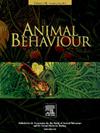Freeze or escape? Tadpoles' behavioural decisions based on conspecifics' chemical alarm cues
IF 2.3
2区 生物学
Q2 BEHAVIORAL SCIENCES
引用次数: 0
Abstract
Optimal antipredator strategies are crucial for prey animals to stay safe without sacrificing opportunities for resource exploitation in their environment. Such optimization requires the flexibility to adapt to different predation scenarios, which in turn requires some kind of assessment of the predation risk, pondering trade-offs and selecting some component(s) of a behavioural repertoire to be displayed as responses. For aquatic animals, including amphibian larvae, chemosensory cues tend to be important in detecting danger and eliciting a response to it. However, the extent to which different aspects of chemical cues can be perceived, discriminated, interpreted and used to shape an antipredator response remains unknown. Here, we tackle the problem using tadpoles of the toad Rhinella arenarum as the experimental model. We exposed them to chemical alarm cues in which we manipulated the source, concentration and spatial distribution. Video-tracking individually tested tadpoles allowed us to perform a precise analysis of the antipredator behaviours in R. arenarum larvae, obtaining details of their antipredator strategy that are usually missed when tadpoles are tested in groups or when the analysis is restricted to the general change in activity. The responses included active and passive behaviours, including freezing, fleeing (usually changing their swimming direction) and avoiding areas displayed in specific locations and moments. This suggests that tadpoles can extract different types of information from chemical cues and use it to tune their behavioural outputs. Furthermore, our results show that cue variation in a single sensory modality can be sufficient to modulate opposing antipredator responses, such as freeze and flight behaviours.
求助全文
约1分钟内获得全文
求助全文
来源期刊

Animal Behaviour
生物-动物学
CiteScore
4.60
自引率
8.00%
发文量
236
审稿时长
10.2 weeks
期刊介绍:
Growing interest in behavioural biology and the international reputation of Animal Behaviour prompted an expansion to monthly publication in 1989. Animal Behaviour continues to be the journal of choice for biologists, ethologists, psychologists, physiologists, and veterinarians with an interest in the subject.
 求助内容:
求助内容: 应助结果提醒方式:
应助结果提醒方式:


